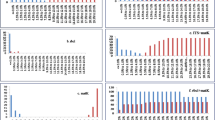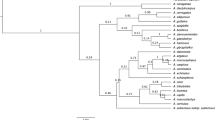Abstract
Garcinia L. is a pantropically distributed genus with high species richness in South East Asia. It is a tropical evergreen plant with distinct morphological characteristics and has a high degree of endemism. Outstanding features of the Garcinia L. genus are monopodial growth, leafy texture, oil cavities containing yellow or light-colored resins present on all parts of the plant and polygamodioecious reproductive behavior. The current study was conducted to develop barcodes for different species of the genus Garcinia L., distributed widely in the Western Ghats of India. We assess the discrimination power of the plant DNA barcode (rbcL, matK, trnH-psbA, rpoB-trnCGAR and ITS), across major Garcinia L. species. Our results clearly demonstrate the value of plastid barcode data, previously unavailable for Garcinia L. species. Ten Garcinia L. species and three outgroup taxa selected from the Western Ghats of India for evaluation using four regions in the plastid genome (rbcL matK, trnH-psbA, rpoB-trnCGAR) and nuclear-transcribed spacer (nrITS) in order to discriminate them at the species level. A characteristic feature of all barcodes, maximum likelihood analysis, and Wilcoxon signed-rank test were used for species discrimination. The number of conserved sites were more using matK primer whereas more variables and informative sites found in rpoB-trnCGAR loci. For internal branches of species-specific clusters, maximum likelihood analysis showed a more resolved topology. Wilcoxon signed-rank test indicated a higher divergence for coding and non-coding regions. DNA barcoding was found to be a practical and rapid method for identifying more endemic species. These findings will potentially be helpful in delineating the various species of Garcinia L.








Similar content being viewed by others
Data availability
The data that support the findings of this study are openly available in NCBI (National Center for Biotechnology Information) https://www.ncbi.nlm.nih.gov/.
References
Abraham Z, Malik SK, Rao GN, Biju SL (2006) Collection and characterisation of malabar tamarind [Garcinia cambogia (Gaertn.) Desr.]. Genet Resour Crop Evol 53:401–406. https://doi.org/10.1007/s10722-004-0584-y
Ali MA, Gyulai G, Hidvegi N, Kerti B, Al Hemaid FMA, Pandey AK, Lee J (2014) The changing epitome of species identification-DNA barcoding. Saudi J Biol Sci 21:204–231. https://doi.org/10.1016/j.sjbs.2014.03.003
Anerao J, Jha V, Desai N (2016) Optimization of DNA extraction methods from Garcinia species for ISSR-PCR, RAPD-PCR and DNA barcoding. Asian J Biotechnol 9:35–42. https://doi.org/10.3923/ajbkr.2017.35.42
Carneiro de Melo Moura C, Brambach F, Jair Hernandez Bado K, Krutovsky KV, Kreft H, Tjitrosoedirdjo SS, Siregar IZ, Gailing O (2019) Integrating DNA barcoding and traditional taxonomy for the identification of dipterocarps in remnant lowland forests of sumatra. Plants 8(11):461
Chen SL, Yao H, Han JP, Liu C, Song JY, Shi LC (2010) Validation of the ITS2 region as a novel DNA barcode for identifying medicinal plant species. PLoS ONE 5:e8613. https://doi.org/10.1371/journal.pone.0008613
Chen J, Zhao J, Erickson DL, Xia N, Kress WJ (2015) Testing DNA barcodes in closely related species of Curcuma (Zingiberaceae) from Myanmar and China. Mol Ecol Resour 15:337–348. https://doi.org/10.1111/1755-0998.12319
Chilton NB, Newton LA, Beveridge I, Gasser RB (2001) Evolutionary relationships of trichostrongyloid nematodes (Strongylida) inferred from ribosomal DNA sequence data. Mol Phylogenet Evol 19(2001):367–386. https://doi.org/10.1006/mpev.2001.0938
Corner EJH (1988) Mangosteen family. Wayside trees of malaya, vol 1. Malayan Nature Society, Kuala Lumpur, pp 349–357
De Rojas M, Ubeda J, Cutillas C, Mora M, Ariza C, Guevara D (2007) Utility of ITS1–5.8S-ITS2 and 16S mitochondrial DNA sequences for species identification and phylogenetic inference within the Rhinonyssus coniventris species complex (Acari: Rhinonyssidae). Parasitol Res 100:1041–1046. https://doi.org/10.1007/s00436-006-0356-z
Dong W, Xu C, Li C (2015) ycf1, the most promising plastid DNA barcode of land plants. Sci Rep 5:8348. https://doi.org/10.1038/srep08348
Dunning L, Savolainen V (2010) Broad-scale amplification of matK for DNA barcoding plants, a technical note. Bot J Linn Soc 164:1–9. https://doi.org/10.1111/j.1095-8339.2010.01071.x
Fairchild D (1930) Exploring for Plants. The Macmillan Company, New York
Guo YY, Luo YB, Liu ZJ, Wang XQ (2015) Reticulate evolution and sea-level fluctuations together drove species diversification of slipper orchids (Paphiopedilum) in South-East Asia. Mol Ecol 24:2838–2855. https://doi.org/10.1111/mec.13189
Hillis and Bull (1993) An empirical test of bootstrapping as a method for assessing confidence in phylogenetic analysis. Syst Biol 42(2):182–192. https://doi.org/10.1093/sysbio/42.2.182
Jones SW (1980). Morphology and major taxonomy of Garcinia (Guttiferae). PhD. Thesis. University of Leicester (Unpublished).
Kang Y, Deng Z, Zang R, Long W (2017) DNA barcoding analysis and phylogenetic relationships of tree species in tropical cloud forests. Sci Rep 7:12564. https://doi.org/10.1038/s41598-017-13057-0
Li X, Yang Y, Henry RJ, Rossetto M, Wang Y, Chen S (2015) Plant DNA barcoding: from gene to genome. Biol Rev 90:157–166. https://doi.org/10.1111/brv.12104
Liu J, Möller M, Gao LM, Zhang DQ, Li DZ (2011) DNA barcoding for the discrimination of Eurasian yews Taxus L, Taxaceae and the discovery of cryptic species. Mol Ecol Resour 111:89–100. https://doi.org/10.1111/j.1755-0998.2010.02907.x
Liu Z, Ni Y, Liu B (2016) Genetic relationships of several Garcinia species (clusiaceae) revealed by its sequence data. Int Educ Sci Res J 2(3):11–15
Mabberley (2017) Mabberley’s Plant-book: a portable dictionary of plants, their classification and uses. Cambridge University Press, Cambridge
Meier R, Kwong S, Vaidya G, Ng PKL (2006) DNA Barcoding and Taxonomy in Diptera: a Tale of High Intraspecific Variability and Low Identification Success. Syst Biol 55:715–728. https://doi.org/10.1080/10635150600969864
Mitchell C (1993) MultAlin–multiple sequence alignment. Bioinformatics 9(5):614–615. https://doi.org/10.1093/bioinformatics/9.5.614
Mohanan N, Sabu T, Rameshkumar KB, Shameer PS (2017). Conservation and sustainable utilization of Garcinia species of the Southern Western Ghats. Jawaharlal Neharu Tropical Botanical Garden and Research Institute, Palode. Final Report submitted to Department of Forest and Wildlife Govt. Of Kerala.
More RP, Mane RC, Purohit HJ (2016) matK-QR classifier: a patterns based approach for plant species identification. BioData Min 9:39. https://doi.org/10.1186/s13040-016-0120-6
Nazre M (2014) New evidence on the origin of mangosteen (Garcinia mangostana L.) based on morphology and ITS sequence. Genet Resour Crop Evol. https://doi.org/10.1007/s10722-014-0097-2
Nazre M, Clyde MM, Latif A (2007). Phylogenetic relationship of locally cultivated Garcinia species with some wild relatives. Malays Appl Biol 36 (1): 31–40. https://www.researchgate.net/publication/225284544_Phylogenetic_relationships_of_locally_cultivated_Garcinia_species_with_some_wild_relatives
Pei N, Erickson D, Chen B (2015) Closely-related taxa influence woody species discrimination via DNA barcoding: evidence from global forest dynamics plots. Sci Rep 5:15127. https://doi.org/10.1038/srep15127
Piredda R, Simeone MC, Attimonelli M, Bellarosa R, Schirone B (2011) Prospects of barcoding the Italian wild dendroflora: oaks reveal severe limitations to tracking species identity. Mol Ecol Resour 11:72–83. https://doi.org/10.1111/j.1755-0998.2010.02900.x
Rousseau-Gueutin M, Keller J, de Carvalho JF, Aïnouche A, Martin G (2018). Chapter 4: the intertwined chloroplast and nuclear genome coevolution in plants. Plant Growth and Regulation-Alterations to Sustain Unfavorable Conditions: 61–84. doi: https://doi.org/10.5772/intechopen.75673.
Saleh MN (2006) Taxonomic revision and molecular studies of Garcinia section Garcinia (Guttiferae). The University of Edinburgh and Royal Botanical Garden Edinburgh, Thesis submitted for Doctor of Philosophy
Seethapathy GS, Tadesse M, Urumarudappa SKJ, Gunaga SV, Vasudeva R, Malterud KE, Shaanker RU, de Boer HJ, Ravikanth G, Wangensteen H (2018) Authentication of Garcinia fruits and food supplements using DNA barcoding and NMR spectroscopy. Sci Rep 8:10561. https://doi.org/10.1038/s41598-018-28635-z
Shameer PS, Rameshkumar KB, Mohanan N (2019) Diversity of Garcinia species in the Western Ghats: phytochemical perspective. JNTBGR. https://www.researchgate.net/publication/320799025_Diversity_of_Garcinia_species_in_the_Western_Ghats_Phytochemical_Perspective
Sivu AR, Pradeep NS, Rameshkumar KB (2017). Chapter 15. Molecular Characterization of Garcinia species in the Western Ghats. Diversity of Garcinia species in the Western Ghats: phytochemical perspective JNTBGRI. JNTBGR. 196–201.
Stevens P (2007). Clusiaceae- Guttiferae. In: Kubitzki K. (ed.), The families & genera of vascular plants. Volume 9. Flowering Plants Eudicots, Springer Verlag, Berlin. pp. 48–66. DOI: https://doi.org/https://doi.org/10.1007/978-3-540- 32219–1_10.
Subbotin SA, Vierstraete A, Ley PD, Rowe J, Waeyenberge L, Moens M, Vanfleteren JR (2001) Phylogenetic relationships within the cyst-forming nematodes (Nematoda, Heteroderidae) Based on Analysis of Sequences from the ITS Regions of Ribosomal DNA. Mol Phylogenet Evol 21(1):1–16. https://doi.org/10.1006/mpev.2001.0998
Sweeney PW (2008) Phylogeny and floral diversity in the genus Garcinia (Clusiaceae) and relatives. Int J Plant Sci 169(9):1288–1303
Swofford DL (2002). PAUP*. Phylogenetic Analysis Using Parsimony (*and Other Methods). Version 4. Sinauer Associates, Sunderland, Massachusetts.
Tamura K, Peterson D, Peterson N, Stecher G, Nei M, Kumar S (2011) MEGA5: molecular evolutionary genetic analysis using maximum likelihood, evolutionary distance, and maximum parsimony methods. Mol Biol Evol 28(10):2731–2739. https://doi.org/10.1093/molbev/msr121
The Plant List (2013). Version 1. Published on the Internet http://www.theplantlist.org/ (accessed 22 May 2016).
Weekers PHH, Jonckheere De, Johan F, Dumont HJ (2001) Phylogenetic Relationships Inferred from Ribosomal ITS Sequences and Biogeographic Patterns in Representatives of the Genus Calopteryx (Insecta: Odonata) of the West Mediterranean and Adjacent West European Zone". Mol Phylogenet Evol 20(1):89–99. https://doi.org/10.1006/mpev.2001.0947
Yao H, Song J, Liu C et al (2010) Use of ITS2 region as the universal DNA barcode for plants and animals. PLoS ONE 5(10):e13102. https://doi.org/10.1371/journal.pone.0013102
Yapwattanaphun C (2003). Phylogenetic analysis of some plants in the genus Garcinia using ITS sequence data and AFLP analysis. PhD. Dissertation. Graduate School, Kasetsart University,
Acknowledgement
The Science and Engineering Research Board, Department of Science and Technology, New Delhi, Government of India, SERB Sanction Order No and date, support this work: SB/YS/LS-25/2014. We also mentioned special thanks to Karnataka Forest Department Bangalore, DCF office Honnavar and Sirsi, Siddapur permitted for collection of samples, Mr. Anil Balanja and NBPGR, Kerala for providing samples.
Author information
Authors and Affiliations
Contributions
JA, ND, VJ designed the study; NS, AS, AN and DS conducted lab experiments; JA and GR Rao collected the species. JA, VJ and ND analyzed the data; JA, ND, MD and KM wrote the manuscript, and JA as Principle Investigator, supervised the research project.
Corresponding author
Ethics declarations
Conflict of interest
The authors declare that they have no conflict of interest in the publication.
Human and animal rights
This article does not contain any studies with human or animal subjects and does not contain any experiments involving human or animals’ participants.
Additional information
Publisher's Note
Springer Nature remains neutral with regard to jurisdictional claims in published maps and institutional affiliations.
Supplementary Information
Below is the link to the electronic supplementary material.
Rights and permissions
About this article
Cite this article
Anerao, J., Jha, V., Shaikh, N. et al. DNA barcoding of important fruit tree species of agronomic interest in the genus Garcinia L. from the Western Ghats. Genet Resour Crop Evol 68, 3161–3177 (2021). https://doi.org/10.1007/s10722-021-01177-6
Received:
Accepted:
Published:
Issue Date:
DOI: https://doi.org/10.1007/s10722-021-01177-6




